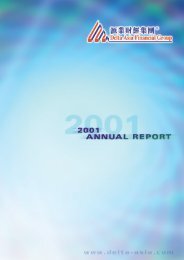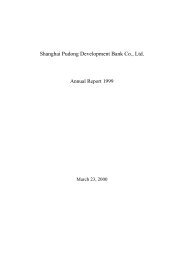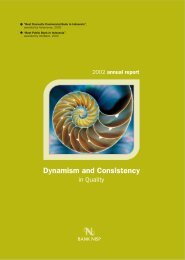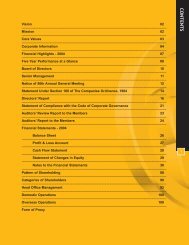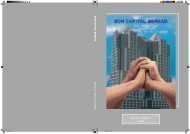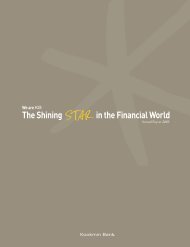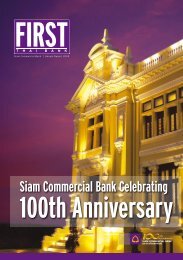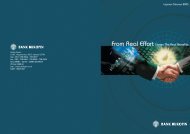Banco de Oro Universal Bank provides a - Asianbanks.net
Banco de Oro Universal Bank provides a - Asianbanks.net
Banco de Oro Universal Bank provides a - Asianbanks.net
- No tags were found...
Create successful ePaper yourself
Turn your PDF publications into a flip-book with our unique Google optimized e-Paper software.
2005 ANNUAL REPORT47Valuation techniques are used to <strong>de</strong>termine fair values which are validated and periodically reviewed. To the extent practicable,mo<strong>de</strong>ls use observable data, however, areas such as credit risk (both own and counterparty), volatilities and correlations requiremanagement to make estimates. Changes in assumptions could affect reported fair value of financial instruments. The Group usesjudgment to select a variety of methods and make assumptions that are mainly based on market conditions existing at each balancesheet date.3.27 Critical Accounting JudgmentsThe following critical accounting judgments may be applicable, among many other possible areas not presented in the financial statements.• Held-to-maturity investments. The Group follows the guidance of PAS 39, Financial Instruments: Recognition and Measurement, onclassifying non-<strong>de</strong>rivative financial assets with fixed or <strong>de</strong>terminable payments and fixed maturity as held-to-maturity. Thisclassification requires significant judgment. In making this judgment, the Group evaluates its intention and ability to hold suchinvestments to maturity. If the Group fails to keep these investments at maturity other than for the allowed specific circumstances– for example, selling an insignificant amount close to maturity – it will be required to reclassify the entire class to available-for-sale.The investments would therefore be measured at fair value not amortized cost. If the entire class of held-to-maturity investmentsis tainted, the fair value would increase by P1,612,889 in the parent company financial statements and P1,660,692 in the consolidatedfinancial statements, with a corresponding entry in the Fair Value Gain on Available-for-Sale Securities account in the statements ofchanges in capital funds.• Impairment of available-for sale financial assets. The Group follows the guidance of PAS 39, Financial Instruments: Recognition andMeasurement on <strong>de</strong>termining when an investment is permanently impaired. This <strong>de</strong>termination requires significant judgment. Inmaking this judgment, the Group evaluates, among other factors, the duration and extent to which the fair value of an investmentis less than its cost; and the financial health of and near-term business outlook for the investee, including factors such as industryand sector performance, changes in technology and operational and financing cash flow.3.28 Risk ManagementBy their nature, the Group’s activities are principally related to the use of financial instruments including <strong>de</strong>rivatives. The Group accepts<strong>de</strong>posits from customers at fixed and floating rates, and for various periods, and seeks to earn above-average interest margins by investingthese funds in high-quality assets. The Group seeks to increase these margins by consolidating short-term funds and lending for longer periodsat higher rates, while maintaining sufficient liquidity to meet all claims that might fall due.The Group also tra<strong>de</strong>s in financial instruments where it takes positions in tra<strong>de</strong>d and over-the-counter instruments, including <strong>de</strong>rivatives, totake advantage of short-term market movements in equities and bonds and in currency and interest rate prices.To manage the financial risk for holding financial assets and liabilities, the Group operates an integrated risk management system to addressthe risks it faces in its banking activities, including liquidity, interest rate, credit and market risks. The Group’s risk management objective isto a<strong>de</strong>quately and consistently evaluate, manage, control, and monitor the risk profile of the Group’s statement of condition to optimize therisk-reward balance and maximize return on the Group’s capital. The Group’s Risk Management Committee has overall responsibility for theGroup’s risk management systems and sets risks management policies across the full range of risks to which the Group is exposed. Specifically,the Group’s RMC places trading limits on the level of exposure that can be taken in relation to both overnight and intra-day market positions.With the exception of specific hedging arrangements, foreign exchange and interest rate exposures associated with these <strong>de</strong>rivatives arenormally offset by entering into counterbalancing positions, thereby controlling the variability in the <strong>net</strong> cash amounts required to liquidatemarket positions.Within the Group’s overall risk management system, Assets and Liabilities Committee (ALCO) is responsible for managing the Group’sstatement of condition, including the Group’s liquidity, interest rate and foreign exchange related risks. In addition, ALCO formulatesinvestment and financial policies by <strong>de</strong>termining the asset allocation and funding mix strategies that are likely to yield the targeted statementof condition results.Separately, the Credit and Risk Management Group (CRMG) is tasked with managing the credit risk, which is the risk that the counterpart ina transaction may <strong>de</strong>fault, and market risk, which is the risk of future loss from changes in the pricing of financial instruments.3.28.1 Market RiskThe Group’s exposure to market risk, the risk of future loss from changes in the price of a financial instrument, relates primarily to its holdingsin foreign exchange instruments, <strong>de</strong>bt securities and <strong>de</strong>rivatives. The Group manages its risk by i<strong>de</strong>ntifying, analyzing and measuring relevantor likely market risks. It recommends various limits based on activity indicators to the Group’s Risk Management Committee. The RiskManagement Committee in turn passes its recommendations to the Board, which reviews and approves these limits on a daily basis.The Group’s market risk management limits are generally categorized as limits on:• Value-at-risk – the CRMG computes the value-at-risk benchmarked at a level which is 20% of projected earnings. The Group usesthe value at risk (VaR) mo<strong>de</strong>l to estimate the daily potential loss that the Group can incur from its trading book, based on a numberof assumptions with a confi<strong>de</strong>nce level of 99%. The measurement is <strong>de</strong>signed such that exceptions over <strong>de</strong>aling limits should onlyarise in very exceptional circumstances.• Stop loss – the CRMG sets the amount of each risk-bearing activity at a percentage of the budgeted annual income for such activity.• Nominal position – the CRMG sets the nominal amount of U.S. dollar <strong>de</strong>nominated instruments at the BSP-mandated U.S. dollaroverbought position limit.• Trading volume – the CRMG sets the volume of transactions that any employee may execute at various levels based on the rank ofthe personnel making the risk-bearing <strong>de</strong>cision.• Earnings-at-risk – the CRMG computes the earnings-at-risk based on 20% of projected earnings.



